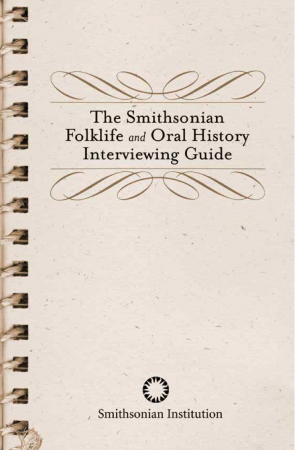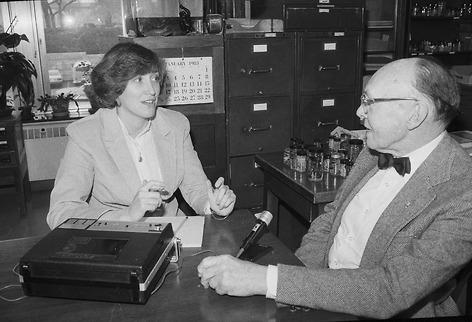Oral history is an integral part of the research and culture at the Smithsonian. But while there are historians, researchers, curators, and volunteers across the Institution conducting oral history interviews, there is no central oral history office or collection at the Smithsonian. Since the medium gained popularity with the rise of social history during the mid-20th century, the Smithsonian considers oral history a methodological tool of research, preservation, and interpretation.
For folks interested in the history of the Smithsonian, look no further than this website right here. The Smithsonian Institution Archives’ Oral History Program began in 1973 and seeks to supplement the manuscript holdings by interviewing Smithsonian employees, volunteers, and community members. With a focus on institutional history, the collection voices the long and varied history of the Smithsonian Institution. The collection has grown from interviews with primarily white male leaders at the Institution to one comprised of interviews with people from every aspect of the Smithsonian Community. Current projects include the history of the use of information technology at the Smithsonian.
Beyond the Archives, incredible oral histories are located across the Smithsonian, so today we’ll be stopping around the different museums and research centers exploring these collections!
Our initial stop is at the first Smithsonian oral history collection—the Anacostia Community Museum (ACM). Then the Anacostia Neighborhood Museum, ACM was founded in 1967 and born out of a commitment to community-collaborative work. Louise Daniel Hutchinson, a member of the team researching Anacostia’s history, coordinated the museum’s early oral history initiative, conducting interviews with Anacostia community members as old as 102. ACM remains committed to local history and continues to be a leader in oral history collection. In 2020, the Museum launched Moments of Resilience to gather stories of how communities supported each other through COVID-19 and racial injustice.

One of the Institution’s more well-known oral history efforts is at the Smithsonian Center for Folklife and Cultural Heritage, which studies cultures from around the globe. The Festival of American Folklife, known today as the Smithsonian Folklife Festival, began in 1967 and spurred several oral history programs that collected family stories from around 200 festival participants from 1974 to 1977 in celebration of the United States Bicentennial.
The Festival of American Folklife employed the use of oral history methodology early on. Dr. Bernice Johnson Reagon, song leader, composer, scholar, and social activist, who in the early 1960s was a founding member of the Student Non-violent Coordinating Committee's Freedom Singers, was a cultural historian who used oral history. The festival continues to commit itself to research, and digital storytelling and oral history is always a present focus at the annual festival. Today Folklife continues to work on incredible projects, like partnering with Howard University to collect interviews for #DontMuteDC: An Oral History. Folklife stands out from other collections as an invaluable source with their Smithsonian Folklife and interview guide for anyone, anywhere to use and even start conducting their own oral histories.
You can find oral history collections at Smithsonian history museums, too. The National Air and Space Museum, has collected oral histories on the history of space and developments in science and technology since 1968. The National Museum of American History (NMAH) also has a long history collecting oral histories that match the breadth of their collections. Edith P. Mayo, a curator in the division of Political history, began using oral history techniques in the 1970s at NMAH—then the National Museum of History and Technology—in her research on the women’s suffrage movement. Today you can explore the impressive collection on the history of invention at NMAH’s Lemelson Center.
One of the newer additions to the Smithsonian already has an incredible collection of interviews. The National Museum of African American History and Culture’s oral history initiative aims to collect and preserve oral histories from iconic elders of African Americana and others who have shaped the culture in significant ways. More recent interview projects can also be found at the National Museum of the American Indian, and the Cooper Hewitt, Smithsonian Design Museum, among others.
Science museums and centers across the Smithsonian—including the National Museum of Natural History and the Smithsonian Tropical Research Institute (STRI) in Panama—conduct oral history interviews to preserve their own institutional history. It’s tough to make frequent trips to STRI, but lucky for us, the staff in Panama is conducting interviews with female scientists to help us learn more about the history of the research center. Another collection to explore is located at the National Anthropological Archives (NAA). The NAA holds recordings created by Smithsonian and non-Smithsonian anthropologists, Native Peoples, researchers, and scientists.
For those of you interested in learning more about the experience of artists, the Archives of American Art (AAA) is the place for you. AAA has been collecting oral histories since 1958—years before it joined the Smithsonian in 1970. It has one of the oldest oral history collections in the country with more than 2,300 interviews. Many of the interview transcripts are available online.

Oral history collections consist of both audio and video interviews in varied analog and digital formats. Most recently, a new Smithsonian-wide Audiovisual Media Preservation Initiatve (AVMPI) began to digitize and preserve these interviews. Today, Smithsonian museums and research centers endeavor to provide greater online access to the wisdom and perspective of those who have shared their memories with us, including Smithsonian community members.
Related Resources
- "Learning Through Listening," by Hannah Byrne , Jessie Aucoin & Marjorie Hunt, Smithsonian Magazine
- How to Do Oral History, Smithsonian Institution Archives
Produced by the Smithsonian Institution Archives. For copyright questions, please see the Terms of Use.

Leave a Comment